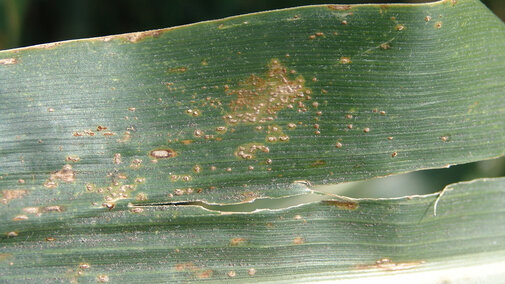Update: Southern rust was confirmed on samples from Richardson, Nemaha, Otoe, and Thayer counties July 20.
Southern corn rust was confirmed in Seward County July 19, York County July 18, Cass and Fillmore counties July 17, and in Cloud County in north central Kansas July 14. (It had previously been confirmed in five more southern Kansas counties.) The disease is likely elsewhere and fields, particularly in southern Nebraska, should be scouted frequently for this disease in the coming weeks.
Southern rust is caused by an aggressive fungus that can cause disease rapidly in susceptible corn hybrids under favorable weather conditions. If it becomes severe, it can cause significant yield loss in susceptible hybrids. Producers and crop advisors should be monitoring fields closely for this disease.
Favorable Weather
Current weather conditions are very favorable for development and spread of southern rust. The pathogen does not overwinter so its spores (urediniospores) must be blown into the area by wind from the south. The fungus needs moisture to germinate and infect, so high relative humidity, rainfall, and irrigation will hasten disease development. Warm temperatures favor southern rust development, especially temperatures in the upper 70s to lower 80s F, even if they occur overnight.
Monitoring
A new southern rust tracking website has been created to help document the distribution of the disease.
Please help us keep the map updated by sharing corn samples with southern rust. Samples submitted to the UNL Plant and Pest Diagnostic Clinic that are microscopically confirmed will be highlighted in red on the map. Other samples that look probable for southern rust in photos will be highlighted in yellow to indicate that the disease is “suspected” until a positive sample is submitted from that county.
Tamra Jackson-Ziems talks with Market Journal host Jeff Wilkerson about the earlier-than-normal outbreak of southern rust in southern Nebraska and how to time treatments to be most effective.

Management
Most corn hybrids are susceptible to the southern rust fungus. Foliar fungicides can effectively manage the disease. Most systemic fungicides can provide protection of leaves from future infections for up to 21-28 days.
The wide range of planting dates across Nebraska this year has resulted in a wide range of corn growth and reproductive stages in fields, some of which are still in the vegetative growth stages. Later planted fields that are earlier in their maturity are at the greatest risk for yield loss if the disease develops there soon. Southern rust can take days to several weeks to develop once it’s identified in an area, so immediate treatment may not be necessary for most fields. Spraying early may mean a second application is necessary later in the season to protect plants during later grain-fill stages as the disease increases in severity once the fungicide has worn off.
Sample Submission
If you're unsure of what you're seeing, submit a sample to the UNL Plant & Pest Diagnostic Clinic for help identifying this or other diseases. The clinic website has information on how to submit a sample and a sample submissions form.
Resource
For more information see the Nebraska Extension NebGuide, Rust Diseases of Corn in Nebraska (G1680).

